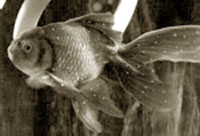|
observer |
|
|
|
|
|
OTHER LINKS |

|

|

|
|
|
|
|
Most goldfish have a tendency to overeat. When goldfish overeat, they produce more waste than normal. If they overeat all the time, they produce more waste than your filter system can handle.
Goldfish should never be given more food than they can eat within five minutes. Young growing goldfish should be fed two or three times a day. Older or mature goldfish should not be fed more than once a day. It will not starve if it is fed only once every other day or even every third day.
On such a feeding schedule, all goldfish are likely to remain healthy and active for many years. Goldfish usually live five to six years, but seldom up to 50 years.
Do you need scavengers?
Scavengers are generally bottom feeders. Most goldfish varieties are also well adapted to be fed from the bottom of the aquarium.
Scavengers in a goldfish aquarium therefore do little for the goldfish, except provide them with unneeded competition for fish food, oxygen and space. But, cat fish are generally believed to be better aquarium scavengers.
If they fall sick
Some goldfish normally swim in an oblique or head downwards position, while others swim in a perfectly horizontal position. If a fish that normally swims horizontally, suddenly starts to swim head down, you can suspect trouble.

Abnormal breathing is also a sign of trouble. If the goldfish take food into their mouths and spit it out, or refuse food altogether, something is definitely wrong!
One of the best ways of preventing disease is to watch your goldfish often and as closely as possible.
Then, you can avoid diseases. At the time of feeding, when changing water and when we are just observing them during leisure are the best times to check the fish out.
Are they male or female?
Under ordinary circumstances, it is difficult to distinguish male from female goldfish. Their sex is prominent only during the breeding period. When the fish are mature during the breeding period, females become swollen with ripe eggs.
|
|
An easier and usually more reliable way to tell their gender is to look for fish with white pimple-like bumps on their head and gill cover; those are males. These bumps are called breeding tubercles and develop just prior to the breeding season. After the eggs are laid, they disappear.
Goldfish can also be identified from their fins. The tectral and pelvic fins of males are hard to touch. Male fish also swim faster. Female fish have fairly short pelvic fins and swim slowly. The scales of the male goldfish are overlapping rows, while those of the female are a loose arrangement.
That's all the fish facts for today. See you again with more facts in our next Pet Den page.










